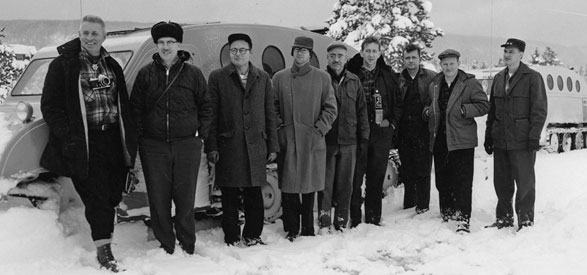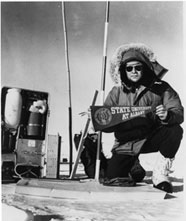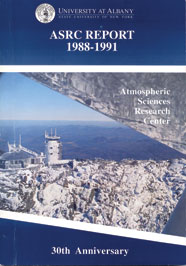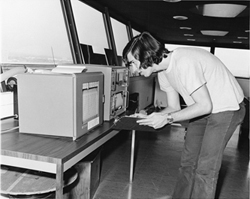
Ask Geoff
By Geoff Williams, University at Albany Archivist
At 50, UAlbany’s Atmospheric Sciences Research Center (ASRC) has built an enviable reputation for investigating the impacts atmospheric phenomena have on us and on our environment.

ASRC researcher Austin Hogan, an expert on aerosols, traveled to Antartica numerous times to study air quality. This photo was taken during the U.S. Antarctic Research Expedition of 1973-74.
Based on a SUNY Board of Trustees-approved plan submitted by Distinguished Lecturer Vincent Schaefer and Oscar Lanford, dean of what was then the State University College of Education at Albany, ASRC was founded Feb. 3, 1961. At a December 1959 conference, representatives of the National Science Foundation’s Atmospheric Science Division; RPI and its Radio-Astronomy Laboratory; General Electric’s General Engineering Laboratories in Schenectady; and the New York State Conservation Department had recommended establishing ASRC at the college and a research station at Whiteface Mountain. The initial budget of $45,000 included $30,000 for equipment and $15,000 for personnel. Lanford became the center’s first director; Schaefer chaired its advisory committee. The new center’s mission called for studying the atmosphere and developing new instrumentation to improve the study of weather.
Soon, ASRC evolved into the headquarters of a major research center. The September 1957 launch of Sputnik, the demonstration of the unmanned satellite’s broadcast capabilities, and the Soviet Union’s subsequent launch of a man into space all pointed to a need for the U.S. government to direct funding toward science in general, and more particularly toward space science and “the Space Race.”

Captured by Volker Mohnen of the ASRC staff, this picture of the Whiteface Observatory appeared on the cover of the center's 30th-anniversary report.
Built in 1970 at a cost of $125,000, not including equipment, the observatory broadcast weather reports 10 years later for the Winter Olympics in Lake Placid.
Prior to serving as dean of the college, Lanford had been a professor and then chairman of the chemistry department. Impressed by the National Science Institute that Schaefer conducted at the Loomis School in Connecticut, Lanford invited him to join the college staff. As a research scientist at GE’s Research Laboratory in Schenectady, Schaefer had discovered the first successful method of cloud seeding in 1947. Later, he was director of Research for the MUNITALP Foundation, which funded atmospheric scientists all over the world. With Schaefer’s addition to the faculty, the college – which would become one of the SUNY System’s four University Centers by 1960 – was able to broaden both its research capabilities and its graduate programs.
At ASRC, Schaefer duplicated the GE-style research center, where good scientists were hired and allowed to pursue their own research interests. Having flourished in that environment, he quickly set about assembling a team that included many of his co-workers on “Project Cirrus,” the U.S. government-run project that aimed to understand and attempt to control the weather. The first new hire was Schaefer’s former colleague Raymond Falconer, a weather-forecasting specialist. Falconer, charged with developing the Whiteface Mountain research facility, would go on to create a widely syndicated weather report and provide weather coverage for the 1980 Lake Placid Olympics. Other ASRC hires included former GE researchers Bernard Vonnegut, who discovered cloud seeding using silver iodide, and Duncan Blanchard, an expert on water droplets.

In this undated photo, a student takes a reading from instruments in the Mohawk Tower ASRC Weather Center on Indian Quad. (If you know who this
unidentified student is, please contact Geoff Williams so we can share that information with readers.)
Early on, Schaefer also demonstrated his ability to attract federal funding and his interest in studying the atmosphere in other venues. Supported by the National Science Foundation, he mounted the first of 10 winter expeditions to Yellowstone Park, where the -40 degrees Celsius conditions were ideal for performing cold-cloud experiments on the ground. One finding borne out by the Yellowstone Field Research Expeditions was the presence of heavy concentrations of lead in the atmosphere in late 1966, a time when
all gasoline contained lead. Schaefer warned of the additive’s impact on “cloud modification,” and by 1973, the federal government was taking steps to eliminate
lead from gasoline.
Supported by grants from such important sources as the National Science Foundation, the U.S. Department of Energy and NASA, ASRC staff have conducted research from the Northeast to the Amazon rain forest, from the Alaskan tundra to Quebec’s boreal forests, and at the South Pole. Through the efforts of researchers like Roger Cheng; Ron Stewart; Richard Perez; Jon Scott; U Czapski; David Fitzjarrald; Ernesto Barreto; Julius Chang; Kenneth Demerjian; Scott Miller; Volker Mohnen; Wei-Chyung Wang; and their predecessors, we have a better understanding of solar energy’s potential; microclimates; the impacts of rain, air pollution, radiation and climate on the environment; the health effects of ultrafine particles in the air; and the causes of acid rain.
I am extremely grateful to David Fitzjarrald for talking with me at length about the history of ASRC, and to Jon Scott and Duncan Blanchard for their helpful comments.
This article draws mainly from Fitzjarrald’s work. His very detailed history of ASRC’s work can be found here.
To submit a question for “Ask Geoff,”
e-mail [email protected].
- UAlbany Magazine
Spring 2011 - Cover Story
- Features
- Departments
- Archives
-
Download the PDF
Spring 2011 issue
(includes the Carillon)




